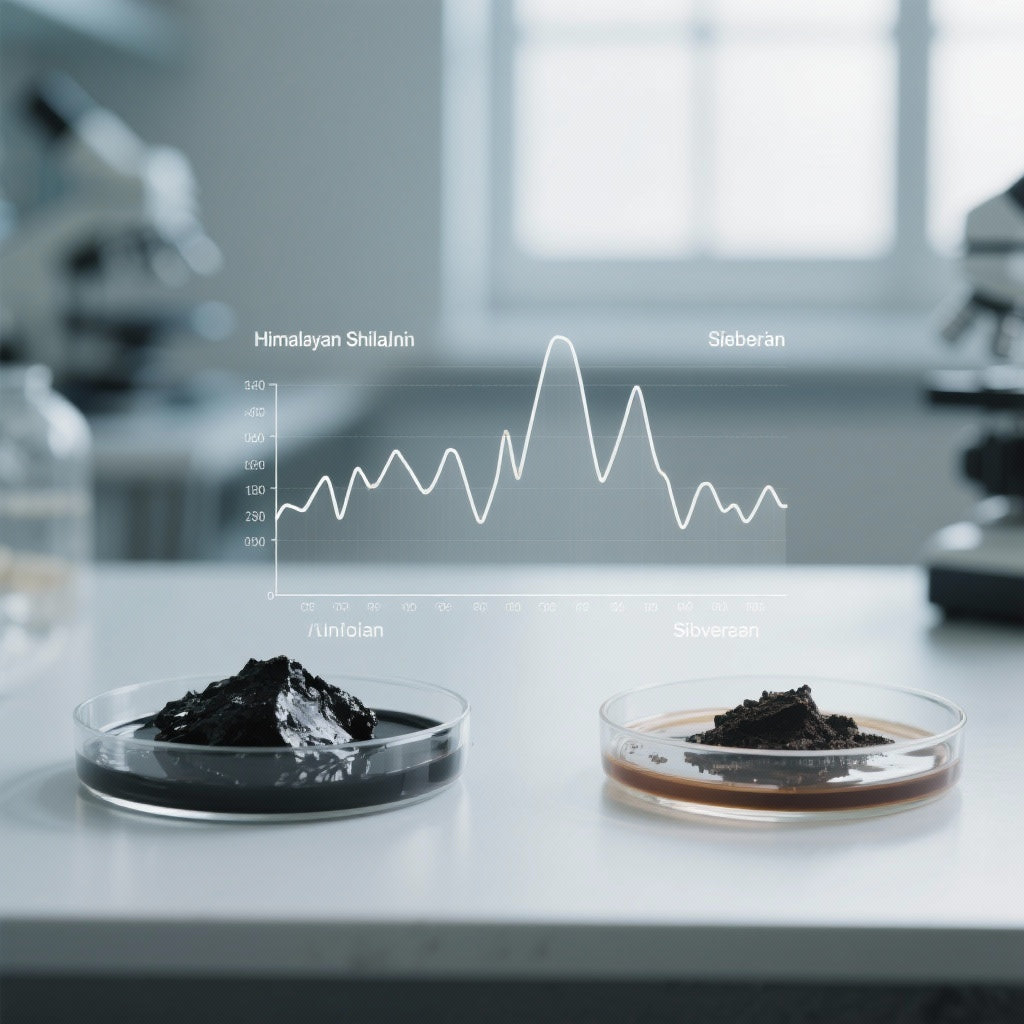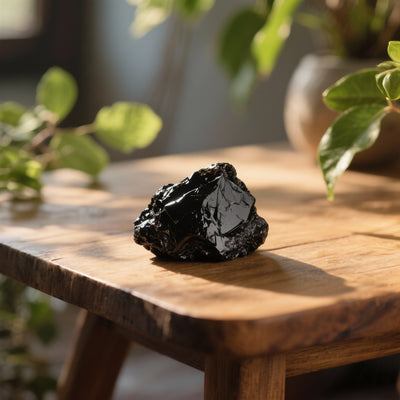Shilajit Himalayan vs. Siberian: Compositional differences revealed by chromatographic analysis
Shilajit, this mysterious resinous substance oozing from the rocks of the world's highest mountains, has experienced a meteoric rise in popularity. Praised for its richness in minerals and bioactive compounds, it has become a cornerstone of natural supplementation. However, a crucial question arises with the proliferation of products on the market: are all Shilajits created equal? The unequivocal answer is no. Between Shilajit from the Himalayas, the original home of this panacea, and its cousin from the Altai Mountains in Siberia, the differences run far deeper than mere geography.
How can we decide and make an informed choice? Modern science offers us a remarkably precise lens: chromatographic analysis. This article invites you to delve into the molecular composition of these two types of Shilajit to reveal what the naked eye cannot see. We will decipher their unique profiles, compare their concentrations of active compounds, and understand why origin is the primary indicator of quality.
Shilajit: A Millennial Geological Treasure
Before comparing them, it's essential to understand what Shilajit is. Often called "sweat of the mountains" or "tears of the rocks," it's a resin resulting from the very slow decomposition of plant matter and minerals, compressed for centuries between layers of rock. This maturation process, called humification, gives rise to a substance extraordinarily dense in nutrients, particularly fulvic acid, minerals, and trace elements.
The crucial importance of the ecosystem
The environment in which Shilajit is formed is crucial to its final composition. Endemic flora, altitude, atmospheric pressure, the mineral composition of the rocks, and even local microbial activity all play a vital role. This is why Shilajit formed at over 5,000 meters altitude in the Himalayas, from unique medicinal plants, cannot be identical to that harvested in the Altai Mountains, a mountain range with a very different climate and geology.
Chromatographic analysis: The molecular signature revealed
For a consumer, it's impossible to distinguish high-quality Shilajit from a lower-quality one by appearance alone. This is where science comes in. Chromatographic analysis, and more specifically High-Performance Liquid Chromatography (HPLC), is the gold standard method for "reading" the chemical composition of a substance.
Imagine Shilajit as a complex orchestra. Chromatography allows us to isolate each musician (each molecule) and measure its importance (its concentration). This technique separates the components of a mixture, allowing us to precisely identify and quantify the key elements:
- Fulvic acid: The conductor, essential for the transport of minerals in our cells.
- Dibenzo-α-pyrones (DBP): Powerful antioxidants and markers of Shilajit authenticity.
- Trace elements: The complete profile of minerals present, from the most common to the rarest.
This analysis provides a true, unforgeable molecular identity card that highlights the fundamental differences between origins.
Himalayan Shilajit: The Profile of Original Black Gold
Shilajit harvested in the highest Himalayan ranges is considered the absolute benchmark, and chromatographic analysis confirms this. The extreme conditions of this region – high altitude, intense pressure, specific medicinal flora (such as Euphorbia royleana ), and freeze/thaw cycles – create a humification process unique in the world.
An unparalleled concentration of active compounds
HPLC analyses of authentic Himalayan Shilajit consistently reveal higher concentrations of active ingredients. Its fulvic acid content is often higher and its molecular structure more complex, thus optimizing its bioavailability. Furthermore, its profile of dibenzo-α-pyrones and associated chromoproteins is particularly rich, indicating superior antioxidant and energy activity.
"The chromatographic profile of pure Himalayan Shilajit is a true molecular symphony. Each peak represents a compound forged by unique conditions. It's a complexity we struggle to find in samples from other regions."
The mineral spectrum is also broader. It contains more than 85 trace elements in ionic form, meaning they are directly assimilated by the body. This richness is a direct reflection of the unique geology of the young Himalayan mountains.
Shilajit of Siberia (Altai Mountains): A distinct composition
Shilajit from the Altai Mountains in Siberia is also an interesting natural substance, but its geological and environmental formation differs from that of the Himalayas. The Altai Mountains are much older, with different flora and mineral composition. These factors result in a distinct chemical profile.
Comparative analysis: what the numbers say
Chromatographic analysis of Siberian Shilajit generally shows:
- A concentration of fulvic acid that is often lower and of a different molecular weight.
- A less diverse and less concentrated Dibenzo-α-pyrones profile.
- A more pronounced presence of humic acids, larger molecules that are less bioavailable than fulvic acid.
- A potentially different mineral spectrum, sometimes with higher concentrations of certain heavy minerals if the purification is not rigorous.
This does not mean that Siberian Shilajit is worthless, but that its "potency" and the synergy of its components, as measured by science, are objectively different and often considered inferior to those of its Himalayan counterpart.
Comparative table: Himalayas vs. Siberia at a glance
Criteria: Origin & Altitude
Himalayas: Very high altitude (+5000m), extreme environment, young and rich geology. Intense pressure promoting concentration.
Siberia (Altai): Lower altitude, older mountains, different climate and flora.
Criterion: Fulvic Acid Concentration
Himalaya: Generally higher, with a complex molecular structure and highly bioavailable.
Siberia (Altai): Variable content, often lower, with a higher proportion of humic acids.
Criterion: High DBP content (Antioxidants)
Himalaya: Rich and diverse profile, marker of strong protective and energetic activity.
Siberia (Altai): Less concentrated and less complex profile.
Criterion: Mineral Profile
Himalaya: Very broad spectrum (more than 85 trace elements) in ionic form, highly assimilable.
Siberia (Altai): Spectrum potentially less complete, depending on specific rock veins.
To delve deeper into the benefits associated with this composition, we invite you to read our full article on the health benefits of Shilajit .
FAQ: Frequently Asked Questions about Himalayan and Siberian Shilajits
- 1. Is Siberian Shilajit of poor quality?
- Not necessarily, but its chemical composition is different and generally less concentrated in key active compounds compared to high-quality Himalayan Shilajit. The choice depends on what you are looking for in terms of potency and spectrum of action.
- 2. Is price a good indicator of origin?
- Often, yes. Pure Himalayan Shilajit is rarer and more difficult to harvest, which justifies a higher price. A very low price should raise concerns about the product's origin, purity, or concentration.
- 3. How can I be sure of the quality of my Shilajit?
- Demand transparency. A reputable brand should provide third-party laboratory analyses (such as chromatography) confirming the fulvic acid concentration and the absence of heavy metals. This is an essential guarantee of trust.
- 4. Can color and taste help me tell the difference?
- Although quality Shilajit should be a black/dark brown resin with a pronounced bitter and smoky taste, these criteria do not differentiate between Himalayan and Siberian origins. Only laboratory analysis can provide conclusive results.
Conclusion: Science as a compass
The comparison between Himalayan and Siberian Shilajit is not a matter of marketing, but of biochemistry. Chromatographic analysis reveals that the unique Himalayan ecosystem creates a substance with superior density and molecular complexity. Himalayan Shilajit's higher concentration of fulvic acid, DBP, and trace elements makes it the preferred choice for those seeking authenticity and maximum effectiveness.
Your well-being deserves the utmost transparency. As an informed consumer, don't settle for promises alone. Trust the science, ask for proof, and choose a source that, like nature, has nothing to hide. Explore our other articles on healthy living to best integrate this treasure into your daily life.
Ready to discover the power of authentic Himalayan Shilajit?
At Purlema, every batch of our Shilajit is rigorously tested by independent laboratories to guarantee its exceptional purity and concentration. Discover the difference superior quality can make.
Discover our purified Shilajit






